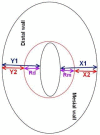Transportation and Centering Ability of Neoniti and ProTaper Instruments; A CBCT Assessment
- PMID: 28179923
- PMCID: PMC5282378
- DOI: 10.22037/iej.2017.09
Transportation and Centering Ability of Neoniti and ProTaper Instruments; A CBCT Assessment
Abstract
Introduction: Transportation is an important iatrogenic endodontic error which might cause failure. This study evaluated the canal transportation caused by Neoniti and ProTaper instruments, using cone-beam computed tomography (CBCT) cross sections.
Methods and materials: This in vitro experimental study was performed on 40 mesiobuccal roots of maxillary first molars. The teeth were scanned with CBCT. They were randomly divided into 2 groups (n=20) that were prepared using either Neoniti or ProTaper files. An endodontist prepared the canal according to the manufacturer's guidelines. Prepared canals were re-scanned. The pre-instrumentation and post-instrumentation CBCT volumes were sectioned at 1 to 9-mm distances from the apex. The extent of canal dentine removal in mesial and distal directions were measured in each cross-section. Canal transportation and instrument centering ability were estimated based on the extents of root wall removal and were compared in both groups.
Results: The groups were rather similar in terms of transportation and centering ability (P>0.05). However, canal preparation on mesial and distal walls was statistically significantly less in the Neoniti group, at most cross-sections. Transportation of both groups was not significantly different (P>0.05). Centering ability of both instruments was not significantly different (P>0.05).
Conclusion: Neoniti and ProTaper instruments might have proper centering ability and minimum transportations. Both instruments might cause similar extents of transportation and centering abilities.
Keywords: Centering Ability; Nickel Titanium Instruments; Root Canal Preparation; Root Canal Treatment; Transportation.
Figures

References
-
- Karabucak B, Gatan AJ, Hsiao C, Iqbal MK. A comparison of apical transportation and length control between EndoSequence and Guidance rotary instruments. J Endod. 2010;36(1):123–5. - PubMed
-
- García M, Duran-Sindreu F, Mercadé M, Bueno R, Roig M. A comparison of apical transportation between ProFile and RaCe rotary instruments. J Endod. 2012;38(7):990–2. - PubMed
-
- Schneider SW. A comparison of canal preparations in straight and curved root canals. Oral Surg Oral Med Oral Pathol Oral Radiol Endod. 1971;32(2):271–5. - PubMed
-
- Alsudani D, Alshahrani S. A Comparison of the Canal Centering Ability of ProFile, K3, and RaCe Nickel Titanium Rotary Systems. J Endod. 2006;32(12):1198–201. - PubMed
LinkOut - more resources
Full Text Sources
Miscellaneous
